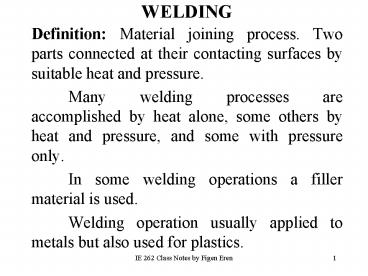WELDING PowerPoint PPT Presentation
1 / 28
Title: WELDING
1
WELDING
- Definition Material joining process. Two parts
connected at their contacting surfaces by
suitable heat and pressure. - Many welding processes are accomplished by heat
alone, some others by heat and pressure, and some
with pressure only. - In some welding operations a filler material is
used. - Welding operation usually applied to metals but
also used for plastics.
2
(No Transcript)
3
Technological and commercial importance
- Provides a permanent joint, welded parts become a
single entity. - Welded joints can be stronger than the parent
material. - Economical way to join components in terms of
material usage and fabrication costs. - No need for factory environment.
4
Limitations
- Manually applied, therefore high labor cost.
- Need high energy causing danger
- Not convenient for disassembly.
- Defects are hard to detect at joints.
5
Types of welding processes
- We can divide welding processes into two major
- groups
- Fusion welding Use heat to melt the base metals.
Usually a filling material is added to provide
strength to the welded joint. If no filling
metals used, it is called autogenous weld. Most
widely used techniques belongs to this category.
6
(No Transcript)
7
Types of welding processes(cont.)
- 2) Solid-state weldingJoining process is
provided by pressure alone or pressure and heat
together. When the pressure is used alone, the
heat is below the melting point.
8
Some groups in fusion welding category
- Arc welding(AW) Heat is accomplished by electric
arc. - Resistance welding(RW) Heat is generated by
electric resistance. - Oxyfuel gas welding(OFW)Mixture of oxygen and
asetylene used to produce a hot flame for melting
the base metal and filler metal(if used). Most
widely used. - Electron beam welding(EBW)
- Laser beam welding(LBW)Better method than EBW,
since laser can be shaped and directed optically,
no vacuum is necessary, and quality becomes
better.
9
Cont.
- 6) Thermit Welding (TW)Thermit Welding
usually uses the exothermic reaction of a mixture
of iron oxide and aluminum powder or other
similar mixtures to weld or repair large forgings
and castings, and join pipes and railroad rails. - The parts are aligned and a ceramic or sand
mold is built around the joint to be formed. The
thermitic mixture reaction is initiated with a
special compound (an oxidizing agent) heating
quickly to the desired temperature which melts
the ends of the parts to be joined. After the
weld cools, excess material is removed by
machining, grinding, or other cutting methods. - Note that, last 3 methods involves reactions
between metals.
10
Arc Welding
11
Resistance welding
12
Oxyfuel gas welding
13
Electron beam welding
14
Laser beam welding
15
Thermit Welding
16
Some groups in solid state welding category
- Diffusion welding(DFW) Two parts are held
together under pressure at elevated temperature. - Friction welding(FRW) By heat of friction
between two surfaces two parts joined. - Ultrasonic welding(USW)Moderate pressure between
two parts hold together and an ultrasonic
oscillation frequency send through in the
direction parallel to the surface of contact. - Forge welding(FOW) Heat and pressure applied.
First the item is heated and hammered. - Cold welding(CW)Only pressure is applied.
- Explosion Welding (EXW)A layer of explosives
placed between layers of materials.
17
Diffusion welding
18
Friction welding
19
Ultrasonic welding
20
Forge welding
21
Cold welding
22
Explosion Welding
23
Commercial operations that use welding
- Construction of buildings, bridges, etc.
- Piping, storage tanks, pressure vessels, etc.
- Ship building.
- Aircraft, aerospace industry.
- Railroads.
24
Weld joint
- There are 5 basic joint types in welding
- Butt joint Two materials are in the same plane,
joined from the edges. - Corner jointThe corners of two materials form a
right angle and joined. - Lap joint Two parts overlaps.
- Tee joint One part is perpendicular to the
other, making a T shape. - Edge joint Edges of the two materials joined.
25
Weld Joints
26
Types of weld
- Fillet weld Used in T joints,corner joints, lap
joints. - Groove weldUsed in butt joints.
- Plug weld Used in lap joints.
- Slot weld Used in lap joints.
- Spot weld Used in lap joints.
- Seam weld Used in lap joints.
- Flange weldUsed in edge joints.
- Surfacing weldNot a joining process, it is used
to increase the thickness of the plate, or
provide a protective coating on the surface.
27
Fillet Weld
Slot and Plug Weld
Groove weld
28
Spot weld
Seam weld
Flange weld

